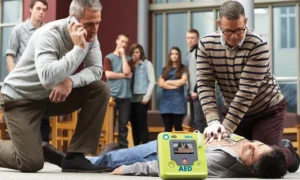The muffled roar of machinery ground to a halt as OSHA inspectors walked onto the floor of a Pennsylvania steel plant last month. Workers had secretly reached out to the agency weeks earlier, reporting cracked safety harnesses, unmarked chemical barrels, and a broken ventilation system. During the OSHA inspection, investigators identified 18 violations—four labeled “willful”—including failure to follow OSHA fire extinguisher inspection requirements and a complete lack of emergency eyewash stations. One welder, whom I’ll call Jake, later told me, “We’d been breathing in metal fumes for years. During the OSHA inspection, they shut down three zones on the spot. It was a relief, but why did it take this long?”
From warehouses to hospitals, OSHA inspections routinely expose hazards that employers dismiss until it’s too late. As a journalist who’s covered workplace safety for over a decade, I’ve seen how gaps in accountability put lives at risk. Let’s unpack the realities of the OSHA inspection process, the types of dangers investigators hunt for, and how workers can demand action when their safety is ignored.
What Sparks an OSHA Inspection? Hint: It’s Not Random
OSHA inspections aren’t arbitrary. They’re triggered by specific events: worker complaints, severe injuries, fatalities, or referrals from media or other agencies. But what type of OSHA inspection is conducted when immediate death or serious injury is likely? These are classified as “imminent danger” inspections—OSHA’s highest priority. Inspectors drop everything to respond, often arriving within hours.
Other common inspection types include:
- Programmed inspections: Targeting high-risk sectors like logging or poultry processing.
- Follow-up inspections: Ensuring past violations were corrected.
- Complaint-driven inspections: Initiated when workers report hazards.
During an OSHA inspection at a Texas oil refinery last year, the trigger was a worker’s anonymous tip about leaking hydrogen sulfide gas—a substance that can kill in seconds. Inspectors found faulty detectors and fined the company $ 268 K “If you feel that an OSHA inspection is needed, don’t second-guess it,” says retired OSHA compliance officer Luis Rivera. “Your call could prevent a funeral.”
Employers must ensure workers complete mandatory safety courses. For comprehensive training, consider OSHA 30 Online, which covers hazard recognition and compliance standards. This course is specially designed for Construction workers, managers, and supervisors to protect them from injuries and hazards.
The OSHA Inspection Process: A Step-by-Step Breakdown
Understanding the OSHA inspection process demystifies what happens when investigators arrive. Here’s how it unfolds:
- The Knock on the Door: Inspectors present credentials and explain why they’re there. Employers must comply or face penalties.
- Opening Conference: Inspectors outline the scope—whether it’s a complaint check or a programmed review of specific hazards.
- The Walkthrough: This is the heart of the process. Inspectors tour the site, photograph violations, and interview workers. They lean heavily on the OSHA inspection checklist, which covers everything from machine guarding to electrical safety.
- Interviews: Workers can speak privately—a critical step. Management isn’t allowed to intimidate or retaliate.
- Closing Conference: Inspectors detail violations and deadlines for fixes.
During an OSHA inspection at a Georgia textile factory, the checklist exposed missing lockout/tagout procedures on dyeing machines. “Workers were inches from losing fingers daily,” the inspector noted. The company later installed safeguards and retrained all staff.
“Imminent Danger”: When OSHA Shuts It Down
The term “imminent danger” isn’t hyperbole—it’s a legal designation for hazards that could cause death or irreversible harm before they’re resolved. Picture a trench without shoring, live wires in standing water, or uncontained asbestos.
What type of OSHA inspection is conducted in these cases? Imminent danger inspections skip the queue. Last June, OSHA halted operations at a Colorado construction site after finding workers in a 20-foot trench with collapsing walls. “They were one rainstorm away from burial,” said Inspector Dana Choi. Employers must fix these risks immediately or face injunctions.
Fire Extinguishers: The Overlooked Lifeline
Fire extinguishers are only useful if they work. Yet, OSHA fire extinguisher inspection requirements are among the most commonly ignored rules. Employers must:
- Perform monthly visual checks (pressure gauges, obstructions, damage).
- Schedule annual professional maintenance.
- Train workers on proper use.
During an OSHA inspection at a Nevada casino, 40% of the extinguishers were expired or blocked by storage boxes. “A fire broke out in their kitchen two years ago,” said OSHA’s regional director. “Employees couldn’t reach the extinguishers—they used flour instead. Miraculously, no one died.”
The OSHA Inspection Checklist: Why It’s Non-Negotiable
The OSHA inspection checklist is the inspector’s playbook. It ensures no hazard goes unnoticed. Key items include:
- Emergency exits: Clear paths? Adequate signage?
- PPE: Is gear provided, maintained, and used?
- Hazard communication: Are chemicals labeled? Are safety data sheets accessible?
- Recordkeeping: Logs of injuries, training, and equipment inspections.
Workers, This Is Your Power Move
You don’t need to wait for a catastrophe. If you feel that an OSHA inspection is needed, here’s your game plan:
- Report the issue to your supervisor (document everything).
- If ignored, file a complaint via OSHA’s website or hotline (1-800-321-OSHA).
- Request anonymity if fearing backlash. Retaliation is illegal, but still happens.
After the Inspection: Penalties, Corrections, and Lessons
Violations aren’t the end—they’re a reckoning. Employers receive citations within six months, categorized as:
- Willful: Deliberate disregard (fines up to $161K per violation).
- Serious: Direct risk of harm (up to $16K).
- Repeat: History of ignoring the same rule.
Companies have 15 days to contest fines or submit abatement plans. After the Pennsylvania steel plant’s inspection, management hired a safety director, replaced all harnesses, and added air quality monitors. “We’re rebuilding trust,” the plant manager claimed. Workers I spoke to remain skeptical but hopeful.
Test Your Knowledge: During OSHA Inspection Quizlet
Ever stumbled on a during osha inspection quizlet while prepping for a safety exam? These quizzes help workers grasp their rights. Try these real questions:
- Q: During an OSHA inspection, can your employer punish you for speaking to inspectors?
A: No—retaliation is illegal under federal law. - Q: What must employers provide during the inspection?
A: Access to all areas, records, and employee interviews without interference.
Knowing during an OSHA inspection answers to these questions empowers workers to hold employers accountable.
The Hard Truth: Complacency Costs Lives
OSHA inspections aren’t about ‘gotcha’ moments, they’re the last line of defense against greed and negligence.” Employers who cut corners aren’t just risking fines—they’re gambling with lives. Workers who stay silent risk becoming statistics.
Ready to protect your team? Start with OSHA Training Online to ensure compliance and empower employees with critical safety knowledge.































